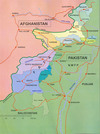As the fighting rages between the Taliban and the Pakistani military in North Waziristan, the situation in South Waziristan is quiet. Over 40 days ago, the Baitullah Mehsud, the powerful Taliban commander in South Waziristan, captured nearly 300 Pakistani soldiers without a shot being fired. The Pakistani government has been negotiating for their release ever since.
Just one day after the capture, the government released 100 Taliban prisoners “in an effort to pave the way for the release of 210 kidnapped soldiers.” The Taliban responded by executing and mutilating three of the soldiers and releasing 31 others.
Recently, the Taliban granted BBCUrdo.com access to three of the captured military officers. “BBC correspondent Haroon Rashid interviewed the three officers – Colonel Zafar, Major Atiq Azam and Lieutenant. Farrukh Manssor – at a hideout in North Waziristan where Mehsud’s men took him,” New Kerala reported. The BBC said the reporters were taken to “a base near the border with Afghanistan.”
Baitullah Mehsud said “the government should make efforts for their release through negotiations or use force if necessary.” Zulfiqar Mehsud, the Taliban spokesman, said the government was “not being serious” about negotiations, citing the election and the fact that none of those captured “was the son or relative of a general or minister.”
Colonel Zafar, who led the convoy through the Mehsud tribal lands in South Waziristan, described the capture of the Pakistani army company to the BBC.
Pro-Taliban tribesmen had stopped his convoy while he was taking supplies to remote army camps. He said his superior officers instructed him to wait while they negotiated with the militant leadership. This took more than four hours. By then the soldiers realized they were surrounded and it was too late to resist.
The day of the capture, The Long War Journal noted the likelihood that the Pakistani army was aware of the situation but in the end were outgunned by the Taliban, and they surrendered after recognizing their poor tactical situation.
… the Pakistani convoy was well aware of the rising tensions in the region. With the convoy having been stopped at four checkpoints and there being arguments with the Taliban, the Pakistani troops were not taken unawares.
The Taliban either prepared for the operation in advance, or quickly assembled and planned the operation. The Taliban had enough foot soldiers with sufficient heavy weapons placed in prepared fighting positions to impress upon the regular Pakistani army officers to surrender without firing a shot. Depending on the terrain and available armaments to the Taliban, perhaps 500 to 1,000 Taliban fighters were on hand to conduct the operation. As we have noted in the past, the Taliban are organizing into well-trained military formations.
The Pakistani troops also surrendered while knowing that 19 soldiers were currently in the custody of Baitullah Mehsud’s Taliban. One of those soldiers was brutally beheaded by a 12-year-old boy. This gruesome acted was videotaped and distributed to the media as a warning.
The Taliban’s ability to capture an entire company of Pakistani soldiers speaks to their organizational ability and training. This operation and others were a precursor to the Taliban’s military ability to fight the Pakistani military in North Waziristan.
Baitullah Mehsud has organized both an unofficial professional military and a dangerous terrorist organization. The Pakistani government accuses Baitullah of being behind a string of suicide bombings throughout Pakistan. Most recently, Baitullah threatened to assassinate former Prime Minister Benazir Bhutto upon her scheduled return to Pakistan.
 Please support The Long War Journal by donating to Public Multimedia Inc., our nonprofit media organization and publisher of The Long War Journal. All donations are 100 percent tax-deductible, and all donations will be used to support The Long War Journal.
Please support The Long War Journal by donating to Public Multimedia Inc., our nonprofit media organization and publisher of The Long War Journal. All donations are 100 percent tax-deductible, and all donations will be used to support The Long War Journal.










5 Comments
Surprising that the Pakistan would allow there troops to be humiliated in this way. I was under the impression they were capable and reasonably adept. Where was the air support and contingency planning? My god 1,000 plus Taliban formations!
Perhaps wiser commentators can offer some more explanation.
regards,
Tim
Trackbacked by The Thunder Run – Web Reconnaissance for 10/12/2007
A short recon of what’s out there that might draw your attention, updated throughout the day…so check back often.
I’m less convinced of the Taliban fighting ablilities than the lack of the same in the Pakistani military. I don’t see how the commander of the Pakistani column could have let himself fall into a trap like that. Is collusion possible in this case?
Freedom descendant and ascendant, in opposite hemispheres
We haven’t “paid much attention” to Latin America lately, since Bush’s appointees do not get approved (not since 2001, when he took office – think Otto Reich) and regional bad actors have solid Congressional support, so Washingt…
I WOULD NOT DOUBT AT ALL THAT THE T-BAN WAS TIPPED OFF BY THIER MAIN ALLY, THE P-STANI ISI. EITHER THAT OR THEY ARE GUTLESS AND INEPT. BILL, IS THIER ANY US ARMOR [STRYKER, BRADLEYS, MBT’S] IN A-STAN?